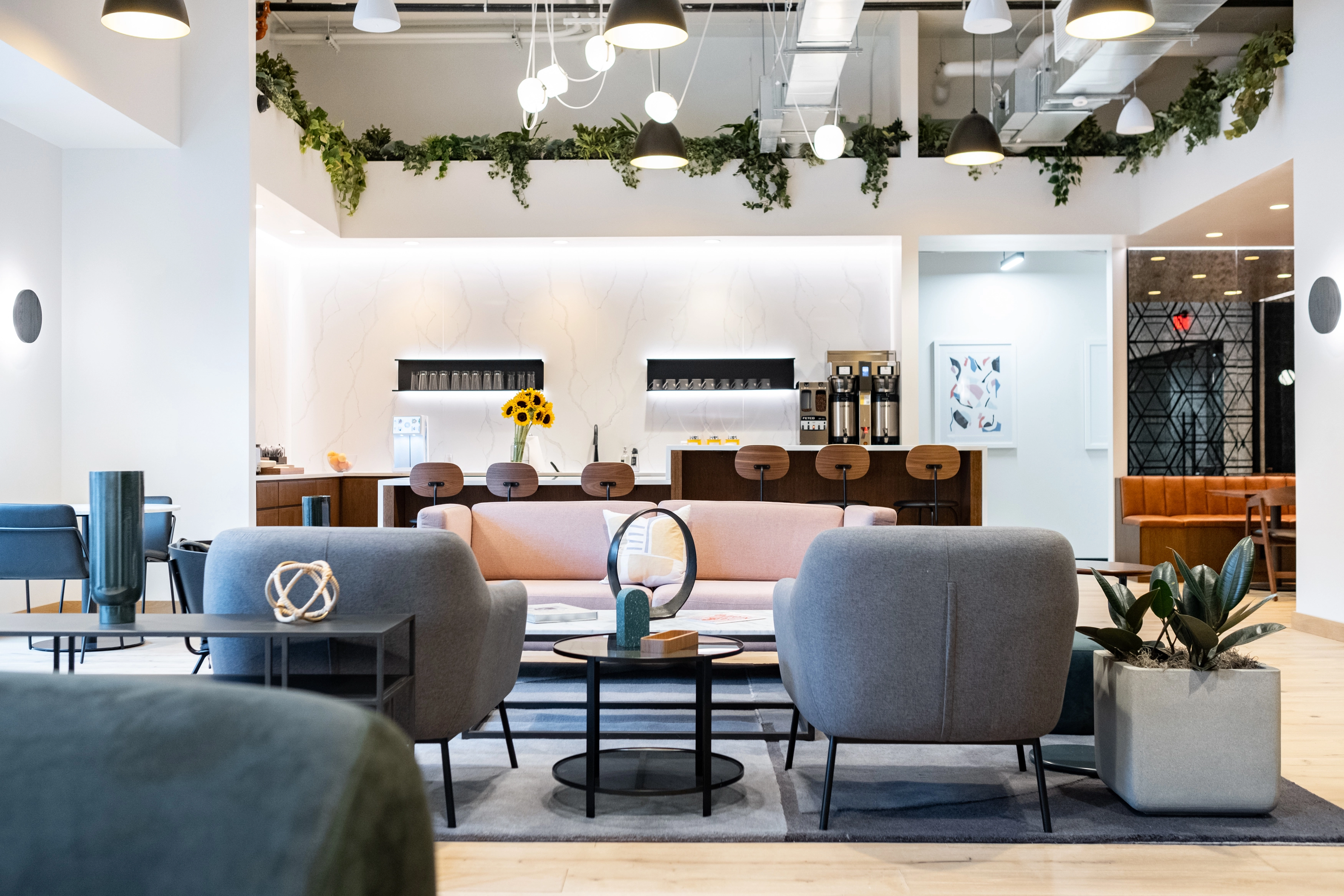Carmel buyers love flexible rooms but flex still needs function. Walk through any Pulte community in Carmel, from Ambleside Townhomes to Meadowstone, and you’ll find floor plans designed around adaptability. First-floor flex rooms that work as guest bedrooms, formal dining rooms that convert to offices, and bonus rooms that handle everything from homework to Zoom meetings. But flexibility without infrastructure leaves families improvising with furniture that doesn’t quite fit the space.
The challenge isn’t finding room to work. It’s making that room work efficiently while looking intentional rather than improvised. A folding table against a wall reads temporary. Mismatched bookcases look cluttered. Storage boxes stacked in corners suggest the space isn’t really finished. Smart built-ins solve these problems by creating infrastructure that supports serious work while appearing to be part of the home’s original design.
We design office built-ins that fit common Carmel floor plans from Pulte and other area builders, finished to look original not aftermarket. From crown molding that matches existing trim to file storage that actually accommodates legal-size documents, these installations transform flexible spaces into productive offices that enhance property value while serving daily needs.
Measure Once, Build Forever: Crown Heights vs Ceiling Relationships
Getting crown molding proportions right determines whether built-ins feel integrated or added as an afterthought. Carmel homes typically feature 9-10 foot ceilings with existing crown molding ranging from 3-5 inches depending on the builder’s trim package. Matching these proportions exactly creates the seamless appearance that makes custom built-ins look factory-installed.
Most Pulte floor plans include crown molding in main living areas but may skip it in flex rooms designated as offices. This presents an opportunity to extend the home’s established crown profile into the office space as part of the built-in installation. When crown molding wraps from the built-in cabinetry onto adjacent walls, it creates visual continuity that suggests the entire room was designed as an office from the beginning.
The relationship between crown height and ceiling height follows established architectural proportions. In rooms with 9-foot ceilings, 4-inch crown molding provides appropriate scale without overwhelming the space. 10-foot ceilings can handle 5-6 inch profiles that create more dramatic presence. The key is maintaining consistency with existing trim throughout the home while ensuring the built-in cabinetry feels proportionate to the room’s actual dimensions.
Installation details matter tremendously for achieving seamless appearance. Crown molding must be scribed perfectly to ceiling irregularities, joints must be tight and properly caulked, and paint preparation must eliminate any evidence of seams. When executed properly, guests assume the built-ins were installed during original construction rather than added later. This level of finish work directly impacts both daily satisfaction and eventual resale value.
File Drawer Sizing That Actually Fits Hanging Folders
Standard residential cabinetry often includes drawers labeled as “file drawers” that don’t actually accommodate standard business filing needs. Legal-size documents, which are common in professional work, require drawer interiors measuring at least 15 inches deep. Letter-size hanging folders need 12.5 inches. Many builder-grade cabinets fall short of these requirements, forcing improvised storage solutions that defeat the purpose of organized filing.
Professional file drawer construction requires more than just adequate dimensions. Full-extension slides ensure complete access to files stored in the back of deep drawers. These slides must be rated for the weight of fully loaded file drawers standard drawer slides will fail under the load of packed hanging folders. Quality file drawers also include adjustable hanging folder frames that accommodate different file arrangements without sagging or binding.
The positioning of file drawers within built-in systems affects both ergonomics and aesthetics. Drawers located too high require reaching overhead to access files, while those positioned too low force uncomfortable bending. The optimal height places file drawer handles 24-30 inches above the floor, allowing comfortable access while seated or standing. This positioning also integrates well with desk surfaces and keyboard tray heights.
Lock mechanisms become important when office built-ins house sensitive business documents or personal financial records. Quality file cabinets include locks that secure multiple drawers simultaneously while maintaining easy access for daily use. Integration of locking mechanisms into custom built-ins requires planning during the design phase to ensure locks don’t compromise the overall aesthetic while providing necessary security for important documents.
Lighting Integration: Puck vs Linear Inside Shelving Systems
Proper lighting transforms built-in shelving from storage into display while providing functional task illumination for office work. The choice between puck lights and linear LED strips depends on shelf spacing, intended use, and desired aesthetic. Each approach offers distinct advantages when integrated thoughtfully into custom cabinetry design.
Puck lights work exceptionally well for highlighting specific objects or creating pools of accent lighting within bookshelf displays. Their compact size allows installation in shallow shelves while providing focused illumination that doesn’t spill beyond the intended area. Quality puck lights include dimming capabilities and color temperature adjustment, allowing customization based on time of day or specific tasks. Installation requires careful planning to ensure electrical connections remain hidden while switches remain accessible.
Linear LED strips provide more uniform illumination across entire shelf lengths, making them ideal for working bookshelves where consistent reading light is needed. Modern LED strips offer remarkable flexibility in terms of color temperature, dimming, and even color-changing capabilities. The key advantage lies in their ability to light entire shelf contents evenly without creating harsh shadows or bright spots that interfere with reading or computer work.
Installation considerations differ significantly between lighting approaches. Puck lights require individual electrical connections and switching, which can become complex with multiple shelving levels. LED strips can often be linked in series, simplifying wiring while providing consistent control. Both approaches benefit from integration with smart home systems, allowing lighting adjustment based on time of day, occupancy, or specific work requirements. Professional installation ensures proper electrical safety while maintaining clean aesthetic lines.
Desk Surface Materials That Handle Daily Professional Use
Built-in desk surfaces receive intensive daily use that tests durability in ways furniture stores rarely demonstrate. Computer equipment, coffee cups, papers, and writing implements create wear patterns that reveal material quality over months of use. Selecting appropriate surface materials prevents replacement needs while maintaining professional appearance throughout years of heavy use.
Solid wood surfaces offer natural beauty and can be refinished when wear becomes visible, but they require maintenance and protection from moisture damage. Ring stains from coffee cups, ink marks, and scratches from daily use will accumulate over time. However, quality hardwood surfaces can be sanded and refinished, essentially providing unlimited renewal capability. The investment in solid wood pays dividends for families planning long-term occupancy.
Laminate surfaces have improved dramatically in recent years, with high-pressure laminates offering remarkable durability and realistic wood or stone appearances. These surfaces resist staining, scratching, and moisture damage while requiring minimal maintenance. Modern laminates can convincingly replicate expensive materials at a fraction of the cost, making them practical choices for active family offices where durability outweighs luxury.
Quartz surfaces represent the premium option for built-in desk surfaces, offering virtually indestructible performance with minimal maintenance requirements. Heat resistance, stain resistance, and scratch resistance make quartz ideal for heavy-use office environments. The non-porous surface prevents bacterial growth, making it hygienic for food and drink consumption during long work sessions. While expensive initially, quartz surfaces essentially eliminate replacement costs throughout the home’s lifetime.
Cable Management Systems for Clean Technology Integration
Modern home offices require extensive technology integration that can quickly turn organized spaces into tangled messes of cables and power supplies. Professional cable management systems built into custom cabinetry hide necessary wiring while providing easy access for equipment changes and upgrades. Proper planning prevents the rats’ nest of cables that characterizes many home office setups.
Built-in wire management starts with adequate power supply planning. Modern offices require numerous outlets for computers, monitors, printers, phone chargers, and various other devices. Installing dedicated circuits prevents overloading while providing clean power for sensitive electronics. Outlets should be positioned strategically to minimize visible cord runs while providing convenient access for daily equipment use.
Grommets and channels routed into desktop surfaces allow cables to pass through cleanly while maintaining organized routing. These channels should be sized generously to accommodate future technology additions without requiring cabinetry modifications. Removable covers allow easy access for cable changes while maintaining clean lines when closed. Professional installation ensures proper sizing and positioning for both current needs and future expansion.
Under-desk cable management systems keep power supplies and excess cable length organized and accessible. These systems typically include mounting brackets for power strips, cable ties for organization, and ventilation considerations for equipment cooling. The goal is creating a system that looks intentional and organized while providing flexibility for changing technology requirements. Quality cable management prevents the accumulation of dust and debris that plagues poorly organized systems.
Storage Solutions Beyond Standard Bookshelf Configurations
Effective home office storage goes far beyond basic bookshelf arrangements to accommodate the full range of materials modern professionals need to organize. From large-format documents to office supplies, reference materials, and personal items, comprehensive storage systems prevent office clutter while maintaining professional appearance.
Adjustable shelving provides flexibility for changing storage needs as work requirements evolve. Quality adjustable systems use metal shelf pins and properly drilled holes to ensure shelves remain level and stable under load. Shelf spacing should accommodate typical office storage items—standard books, three-ring binders, storage boxes, and decorative objects. The ability to reconfigure shelving prevents obsolescence as storage needs change over time.
Specialty storage solutions address specific professional requirements that standard shelving cannot accommodate. Map drawers for architects, sample storage for designers, and supply organization for crafters require custom approaches that integrate seamlessly with overall office design. These specialized storage solutions often justify the entire built-in investment by providing functionality impossible to achieve with standard furniture.
Concealed storage maintains clean visual lines while providing substantial capacity for items that don’t need daily access. Cabinets with solid doors hide seasonal decorations, archived files, and bulk office supplies while maintaining organized appearance. Interior organization systems within concealed storage maximize capacity while preventing the jumbled mess that often accumulates in closed storage areas.
Ergonomic Considerations for Built-In Desk Heights and Depths
Proper ergonomics prevent the physical problems that can develop from hours of daily computer work while ensuring built-in offices remain comfortable for users of different heights. Standard desk height may not work optimally for every family member, and custom built-ins offer opportunities to optimize dimensions for primary users while accommodating occasional use by others.
Desk height significantly affects posture and comfort during extended work sessions. Standard desk height of 29-30 inches works well for users of average height, but taller individuals benefit from 31-32 inch surfaces while shorter users may prefer 27-28 inches. Built-in installations can accommodate these preferences while maintaining aesthetic proportions. Adjustable keyboard trays provide additional ergonomic flexibility without compromising desktop space for other activities.
Desk depth determines legroom and workspace functionality for various tasks. Minimum depth of 24 inches accommodates basic computer work, but 30-36 inch depths provide space for spread-out projects, reference materials, and multiple monitors. Deep desks also allow computer monitors to be positioned at optimal viewing distances, reducing eye strain during extended work sessions. The depth must be balanced against room dimensions to prevent the built-in from overwhelming the space.
Footroom under built-in desks requires careful planning to ensure comfort during extended sitting periods. Toe kicks should be sized appropriately, typically 3-4 inches deep and 4 inches high, to allow comfortable foot positioning. Cable management systems must not interfere with leg space, and any under-desk storage should be positioned to avoid knee conflicts. These details seem minor during planning but significantly affect daily user satisfaction.
Integration With Existing Architectural Elements
Successful built-in offices look like original architectural features rather than furniture added after construction. This requires careful attention to existing trim profiles, door and window casings, and overall design vocabulary established throughout the home. Integration details determine whether built-ins appear custom or obviously retrofitted.
Trim matching requires precise duplication of existing profiles throughout the home. Door casings, window trim, and baseboard profiles should be replicated exactly in built-in construction. This often requires custom milling of trim pieces to match builder profiles that may not be available at retail lumber yards. The investment in proper trim matching creates seamless integration that significantly enhances perceived value.
Color coordination extends beyond simple paint matching to consider sheen levels, texture, and aging characteristics. New paint on built-ins may not match existing paint that has aged and changed color over time. Professional color matching services can account for these variations, ensuring built-ins blend seamlessly with existing finishes. Consider the lighting conditions in the office space, as colors can appear different under various light sources throughout the day.
Flooring transitions require careful planning to maintain clean lines where built-ins meet existing floor surfaces. Baseboards must be scribed to accommodate flooring irregularities while maintaining consistent reveals around built-in elements. When built-ins extend to the floor, proper underlayment and moisture barriers prevent flooring problems that can develop over time. Professional installation ensures these details are handled correctly from the beginning.
Why These Details Matter in Carmel Homes
Carmel’s competitive real estate market rewards homes with custom details that set them apart from standard builder offerings. Professional home office built-ins represent exactly the kind of upgrade that appeals to the area’s educated, professional population while providing immediate functional benefits for current occupants. The work-from-home trend has permanently changed how families use their homes, making dedicated office space a necessity rather than a luxury.
The 223 subdivisions throughout Carmel represent varying price points and architectural styles, but they share common characteristics: quality construction, spacious floor plans, and residents who value both form and function. Built-in home offices align perfectly with these values by providing professional-grade functionality wrapped in custom millwork that appears to be original to the home.
Pulte’s emphasis on flexible floor plans throughout Carmel communities creates perfect opportunities for office built-ins that transform adaptable spaces into purpose-built work environments. These installations maximize property value while improving daily life quality for the growing number of professionals who work from home either full-time or hybrid schedules.
Ready to Transform Your Carmel Home Office?
At Radford Woodworks, we specialize in built-in office solutions that integrate seamlessly with Carmel’s most popular floor plans from Pulte and other area builders. Our experience with local architectural styles ensures your office built-ins look like original features while providing modern functionality that supports professional success.
Follow our social media accounts for daily inspiration and project updates, then call (317) 739-8555 to get your personalized quote. Visit radfordwoodworks.com/contact to see our portfolio of Carmel office transformations.
Your flexible room has potential. Let’s build the infrastructure that turns potential into productivity.






